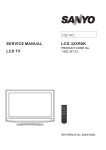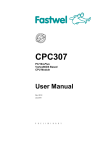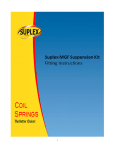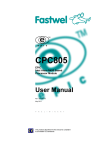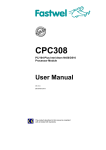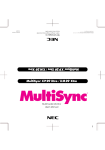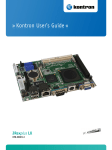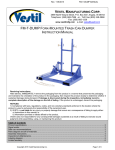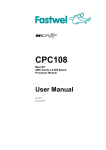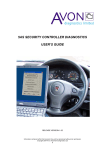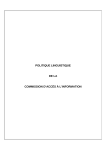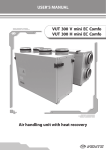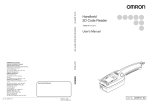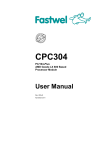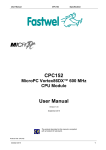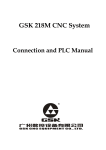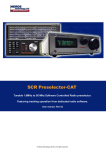Download CPC306 User Manual 002 E
Transcript
CPC306 PC/104-Plus Vortex86DX Based CPU Module User Manual Rev. 002a E February 2012 Product Title: Document name: Manual version: Ref. doc. v.: CPC306 CPC306 User Manual 002a E 2.1 R (467444 031) Copyright © 2011, 2012 Fastwel Co. Ltd. All rights reserved. Revision Record Rev. Index Brief Description of Changes Board Index Date of Issue 001 Initial preliminary version (incomplete) CPC306 PCB v.3.0 + KIB386 August 2011 002 Functional description and BIOS sections added CPC306 PCB v.3.0 + KIB386 October 2011 002a Dimensions corrected CPC306 PCB v.3.0 + KIB386 February 2012 Contact Information Fastwel Co. Ltd Fastwel Corporation US Address: 108 Profsoyuznaya st., Moscow 117437, Russian Federation 45 Main Street, Suite 319 Brooklyn, New York 11201 USA Tel.: +7 (495) 232-1681 +1 (718) 554-3686 Fax: +7 (495) 232-1654 +1 (718) 797-0600 Toll free: E-mail: [email protected] Web: http://www.fastwel.com/ +1 (877) 787-8443 (1-877-RURUGGED) CPC306 Table of Contents Table of Contents ..............................................................................................................................................1 List of Tables .....................................................................................................................................................3 List of Figures ....................................................................................................................................................3 Notation Conventions.........................................................................................................................................5 General Safety Precautions................................................................................................................................6 Unpacking, Inspection and Handling...................................................................................................................7 Three Year Warranty..........................................................................................................................................8 1 Introduction...................................................................................................................................... 9 1.1 1.2 1.3 1.4 2 Technical Specifications.................................................................................................................13 2.1 2.2 2.3 2.4 2.5 2.6 3 Module Introduction.................................................................................................................................9 CPC306 Versions..................................................................................................................................11 Delivery Checklist..................................................................................................................................11 Additional Accessories ..........................................................................................................................12 General.................................................................................................................................................13 Power Requirements.............................................................................................................................15 Environmental.......................................................................................................................................16 Mechanical ...........................................................................................................................................16 Dimensions and Weight.........................................................................................................................17 MTBF ...................................................................................................................................................18 Functional Description ...................................................................................................................19 3.1 3.2 CP C3 0 6 Structure and Layout .............................................................................................................................19 Functional Description...........................................................................................................................24 3.2.1 Vortex86DX SoC ..................................................................................................................24 3.2.2 SDRAM Memory...................................................................................................................25 3.2.3 IDE Interface.........................................................................................................................25 3.2.4 CompactFlash ......................................................................................................................26 3.2.5 ATA Flash Disk .....................................................................................................................27 3.2.6 PS/2 Keyboard and Mouse Interface......................................................................................27 3.2.7 Optoisolated Reset/IRQ Input................................................................................................28 3.2.8 USB Interface .......................................................................................................................29 3.2.9 Fast Ethernet Interface..........................................................................................................29 3.2.10 Serial Ports...........................................................................................................................30 3.2.10.1 COM1 and COM2 .................................................................................................30 3.2.10.2 COM3 and COM4 .................................................................................................33 3.2.11 Parallel Printer Port (LPT) .....................................................................................................34 3.2.12 Expansion Buses: ISA and PCI .............................................................................................35 3.2.12.1 PCI Header...........................................................................................................35 3.2.12.2 ISA Header...........................................................................................................37 3.2.13 Redundancy .........................................................................................................................39 3.2.14 Analog Input/Output ..............................................................................................................40 3.2.15 Discrete Input/Output (UNIO).................................................................................................40 3.2.16 Watchdog Timers..................................................................................................................41 3.2.17 RTC, CMOS, Serial FRAM and Reserved BIOS.....................................................................41 3.2.17.1 Reserved BIOS.....................................................................................................41 3.2.17.2 RTC, CMOS and Battery.......................................................................................41 Us e r M a n u a l 1 © 2 0 1 2 F a s t w e l v . 0 0 2 a E CPC306 3.3 4 External Connections .....................................................................................................................49 4.1 4.2 4.3 4.4 5 3.2.17.3 FRAM...................................................................................................................42 3.2.17.4 BIOS Upgrade ......................................................................................................42 3.2.18 Power Supply .......................................................................................................................42 3.2.19 Power Supply Supervisor ......................................................................................................43 3.2.20 GPIO Ports ...........................................................................................................................43 3.2.21 Configuration Jumpers ..........................................................................................................43 3.2.22 Diagnostic LEDs ...................................................................................................................44 3.2.23 Reset Button.........................................................................................................................44 Address Mapping ..................................................................................................................................45 3.3.1 Memory Addressing ..............................................................................................................45 3.3.2 I/O Addressing......................................................................................................................45 3.3.3 Interrupt Settings ..................................................................................................................47 3.3.4 DMA Channels......................................................................................................................48 Safety Regulations ................................................................................................................................49 Connection of Peripheral Devices ..........................................................................................................50 KIB386 Interface Adapter Module ..........................................................................................................51 Software Installation..............................................................................................................................54 AMI BIOS .........................................................................................................................................55 5.1 5.2 5.3 5.4 5.5 5.6 5.7 5.8 CP C3 0 6 BIOS Setup Program. Introduction.........................................................................................................55 Main Menu............................................................................................................................................55 Advanced .............................................................................................................................................57 5.3.1 CPU Configuration................................................................................................................58 5.3.2 IDE Configuration..................................................................................................................59 5.3.2.1 Primary IDE Master...............................................................................................60 5.3.3 Remote Access Configuration ...............................................................................................61 5.3.4 USB Configuration ................................................................................................................62 Advanced PCI/PnP Settings ..................................................................................................................63 Boot Options.........................................................................................................................................64 5.5.1 Boot Settings Configuration ...................................................................................................65 5.5.2 Boot Device Priority...............................................................................................................66 Security Settings ...................................................................................................................................67 Chipset Menu........................................................................................................................................68 5.7.1 NorthBridge Configuration.....................................................................................................69 5.7.2 SouthBridge Configuration ....................................................................................................70 5.7.2.1 ISA Configuration..................................................................................................71 5.7.2.2 Serial/Parallel Port Configuration...........................................................................72 5.7.2.3 WatchDog Configuration .......................................................................................73 Exit Menu .............................................................................................................................................74 Us e r M a n u a l 2 © 2 0 1 2 F a s t w e l v . 0 0 2 a E CPC306 List of Tables Table 1.1: Table 1.2: Table 1.3: Table 2.1: Table 3.1: Table 3.2: Table 3.3: Table 3.4: Table 3.5: Table 3.6: Table 3.7: Table 3.8: Table 3.9: Table 3.10: Table 3.11: Table 3.12: Table 3.13: Table 3.14: Table 3.15: Table 3.16: Table 3.17: Table 3.18: Table 3.19: Table 3.20: Table 3.21: Table 3.22: Table 3.23: Table 4.1: Table 5.1: Table 5.2: Table 5.3: Table 5.4: Table 5.5: Table 5.6: Table 5.7: Table 5.8: Table 5.9: Table 5.10: Table 5.11: Table 5.12: Table 5.13: Table 5.14: Table 5.15: Table 5.16: Table 5.17: Table 5.18: CPC306 Versions.......................................................................................................................11 CPC306 Supplied Set.................................................................................................................11 CPC306 Additional Accessories..................................................................................................12 Power Supply Requirements.......................................................................................................15 IDE Channel: Devices Connection Variants.................................................................................25 XP17 Connector Pinout (IDE) .....................................................................................................25 XP34 CompactFlash Socket Pinout.............................................................................................26 XP27 Contacts Designation ........................................................................................................27 XP19 Connector Pinout (USB) ....................................................................................................29 XP15 Ethernet Header Pinout .....................................................................................................30 XP8 (COM1) and XP4 (COM2) Pin Assignments .........................................................................30 XP3 and XP7 Pinpads Jumpers ..................................................................................................31 XP13 and XP14 Pin Assignments ...............................................................................................33 XP11 (LPT) Connector Pinout.....................................................................................................34 XS1 Connector Contacts Designation (Rows A, B) ......................................................................35 XS1 Connector Contacts Designation (Rows C, D)......................................................................36 ISA XS2 Connector (Rows A and B) Contacts Designation ..........................................................37 ISA XS2 (Rows C and D) Contacts Designation ..........................................................................38 XP1 Pinout.................................................................................................................................40 XP2 Pinout.................................................................................................................................40 XP26 Power Connector Pinout....................................................................................................42 CPC306 Diagnostic LEDs Function.............................................................................................44 XP9 Contacts Function ...............................................................................................................44 Memory Address Mapping ..........................................................................................................45 I/O Address Space .....................................................................................................................45 Interrupt Settings........................................................................................................................47 DMA Settings .............................................................................................................................48 KIB386-01 and CPC306 Connectors Correspondence.................................................................54 Main Menu Items........................................................................................................................56 Advanced Menu Items ................................................................................................................57 CPU Configuration Items ............................................................................................................58 IDE Configuration Items..............................................................................................................59 Primary IDE Master Items...........................................................................................................60 Remote Access Configuration Items............................................................................................61 USB Configuration Items ............................................................................................................62 PCI / Plug and Play Menu Items..................................................................................................63 Boot Menu Items ........................................................................................................................64 Boot Settings Configuration Items ...............................................................................................65 Security Menu Items...................................................................................................................67 Chipset Menu Items....................................................................................................................68 NorthBridge Configuration Items .................................................................................................69 SouthBridge Configuration Items.................................................................................................70 ISA Configuration Items..............................................................................................................71 Serial/Parallel Ports Settings.......................................................................................................72 WDT0 and WDT1 Settings..........................................................................................................73 Exit Menu Items .........................................................................................................................74 List of Figures Figure 1.1: Figure 2.1: Figure 3.1: Figure 3.2: Figure 3.3: Figure 3.4: CP C3 0 6 Us e r CPC306 Module Appearance......................................................................................................10 CPC306: Overall and Mounting Dimensions................................................................................17 CPC306 Block Diagram..............................................................................................................19 Top Side: Connectors and Main Components Layout...................................................................22 Bottom Side: Connectors and Main Components Layout..............................................................23 Vortex86DX SoC Block Diagram.................................................................................................24 M a n u a l 3 © 2 0 1 2 F a s t w e l v . 0 0 2 a E CPC306 Figure 3.5: Figure 3.6: Figure 3.7: Figure 3.8: Figure 3.9: Figure 3.10: Figure 3.11: Figure 3.12: Figure 3.13: Figure 3.14: Figure 3.15: Figure 3.16: Figure 3.17: Figure 3.18: Figure 3.19: Figure 3.20: Figure 3.21: Figure 3.22: Figure 3.23: Figure 3.24: Figure 3.25: Figure 4.1: Figure 4.2: Figure 4.3: Figure 4.4: Figure 4.5: Figure 5.1: Figure 5.2: Figure 5.3: Figure 5.4: Figure 5.5: Figure 5.6: Figure 5.7: Figure 5.8: Figure 5.9: Figure 5.10: Figure 5.11: Figure 5.12: Figure 5.13: Figure 5.14: Figure 5.15: Figure 5.16: Figure 5.17: Figure 5.18: Figure 5.19: XP17 IDC44 Pins Numbering......................................................................................................25 XP27 Connector Contacts Numbering.........................................................................................27 XP25 Connector.........................................................................................................................28 Discrete Input Optoisolation and Reset or IRQ Source Selection..................................................28 XP19 Connector.........................................................................................................................29 XP15 Connector.........................................................................................................................30 XP8 and XP4 Pins Numbering ....................................................................................................30 XP3 and XP7 Pinpads ................................................................................................................31 RS485/422 Transmitter with Bias Elements and Terminating Resistors ........................................31 Connection of Several Devices in RS422 Mode...........................................................................32 Connection of Several Devices in RS485 Mode...........................................................................32 IDC10 Pins Numbering ...............................................................................................................33 XP20 Connector.........................................................................................................................34 XS1 Connector Contacts Layout .................................................................................................35 ISA Header Contacts Layout.......................................................................................................37 Redundancy Pinpads Connection ...............................................................................................39 XP1 Pinpad................................................................................................................................39 XP2 Pinpad................................................................................................................................40 XP26 Power Supply Connector...................................................................................................42 Power Supply Supervisor Diagram..............................................................................................43 External LEDs Connection (XP9) ................................................................................................44 External Devices Connection ......................................................................................................50 KIB386-01 Connections..............................................................................................................51 KIB386-01 Dimensions ...............................................................................................................52 KIB386-01 Layout, Top...............................................................................................................53 KIB386-01 Layout, Bottom..........................................................................................................53 Main Menu Screen Image...........................................................................................................56 Advanced Screen Image.............................................................................................................57 CPU Configuration Screen Image ...............................................................................................58 IDE Configuration Screen Image.................................................................................................59 Primary IDE Master Screen Image..............................................................................................60 Remote Access Configuration Screen Image...............................................................................61 USB Configuration Screen Image................................................................................................62 PCI / Plug and Play Menu Screen ...............................................................................................63 Boot Menu Screen......................................................................................................................64 Boot Settings Configuration Screen Image ..................................................................................65 Boot Device Priority Screen Image..............................................................................................66 Security Menu Screen ................................................................................................................67 Chipset Menu Screen Image.......................................................................................................68 NorthBridge Configuration Screen Image ....................................................................................69 SouthBridge Configuration Screen Image....................................................................................70 ISA Configuration Screen Image.................................................................................................71 Serial/Parallel Port Configuration Screen Image ..........................................................................72 WatchDog Configuration Screen Image.......................................................................................73 Exit Menu Screen Image.............................................................................................................74 All information in this document is provided for reference only, with no warranty of its suitability for any specific purpose. This information has been thoroughly checked and is believed to be entirely reliable and consistent with the product that it describes. However, Fastwel accepts no responsibility for inaccuracies, omissions or their consequences, as well as liability arising from the use or application of any product or example described in this document. Fastwel Co. Ltd. reserves the right to change, modify, and improve this document or the products described in it, at Fastwel's discretion without further notice. Software described in this document is provided on an “as is” basis without warranty. Fastwel assumes no liability for consequential or incidental damages originated by the use of this software. This document contains information, which is property of Fastwel Co. Ltd. It is not allowed to reproduce it or transmit by any means, to translate the document or to convert it to any electronic form in full or in parts without antecedent written approval of Fastwel Co. Ltd. or one of its officially authorized agents. Fastwel and Fastwel logo are trademarks owned by Fastwel Co. Ltd., Moscow, Russian Federation. Ethernet is a registered trademark of Xerox Corporation. IEEE is a registered trademark of the Institute of Electrical and Electronics Engineers Inc. Intel is a trademark of Intel Corporation. Geode is trademark of AMD. Microsoft is a trademark of the Microsoft corporation. In addition, this document may include names, company logos and trademarks, which are registered trademarks and, therefore, are property of their respective owners. Fastwel welcomes suggestions, remarks and proposals regarding the form and the content of this Manual. CP C3 0 6 Us e r M a n u a l 4 © 2 0 1 2 F a s t w e l v . 0 0 2 a E CPC306 Notation Conventions Warning, ESD Sensitive Device! This symbol draws your attention to the information related to electro static sensitivity of your product and its components. To keep product safety and operability it is necessary to handle it with care and follow the ESD safety directions. Warning! This sign marks warnings about hot surfaces. The surface of the heatsink and some components can get very hot during operation. Take due care when handling, avoid touching hot surfaces! Caution: Electric Shock! This symbol warns about danger of electrical shock (> 60 V) when touching products or parts of them. Failure to observe the indicated precautions and directions may expose your life to danger and may lead to damage to your product. Warning! Information marked by this symbol is essential for human and equipment safety. Read this information attentively, be watchful. Note... This symbol and title marks important information to be read attentively for your own benefit. CP C3 0 6 Us e r M a n u a l 5 © 2 0 1 2 F a s t w e l v . 0 0 2 a E CPC306 General Safety Precautions This product was developed for fault-free operation. Its design provides conformance to all related safety requirements. However, the life of this product can be seriously shortened by improper handling and incorrect operation. That is why it is necessary to follow general safety and operational instructions below. Warning! All operations on this device must be carried out by sufficiently skilled personnel only. Warning! When handling this product, special care must be taken not to hit the heatsink (if installed) against another rigid object. Also, be careful not to drop the product, since this may cause damage to the heatsink, CPU or other sensitive components as well. Please, keep in mind that any physical damage to this product is not covered under warranty. Note: This product is guaranteed to operate within the published temperature ranges and relevant conditions. However, prolonged operation near the maximum temperature is not recommended by Fastwel or by electronic chip manufacturers due to thermal stress related failure mechanisms. These mechanisms are common to all silicon devices, they can reduce the MTBF of the product by increasing the failure probability. Prolonged operation at the lower limits of the temperature ranges has no limitations. Caution, Electric Shock! Before installing this product into a system and before installing other devices on it, always ensure that your mains power is switched off. Always disconnect external power supply cables during all handling and maintenance operations with this module to avoid serious danger of electrical shock. CP C3 0 6 Us e r M a n u a l 6 © 2 0 1 2 F a s t w e l v . 0 0 2 a E CPC306 Unpacking, Inspection and Handling Please read the manual carefully before unpacking the module or mounting the device into your system. Keep in mind the following: ESD Sensitive Device! Electronic modules and their components are sensitive to static electricity. Even a non-perceptible by human being static discharge can be sufficient to destroy or degrade a component's operation! Therefore, all handling operations and inspections of this product must be performed with due care, in order to keep product integrity and operability: n Preferably, unpack or pack this product only at EOS/ESD safe workplaces. Otherwise, it is important to be electrically discharged before touching the product. This can be done by touching a metal part of your system case with your hand or tool. It is particularly important to observe anti-static precautions when setting jumpers or replacing components. If the product contains batteries for RTC or memory back-up, ensure that the module is not placed on conductive surfaces, including anti-static mats or sponges. This can cause shortcircuit and result in damage to the battery and other components. Store this product in its protective packaging while it is not used for operational purposes. n n Unpacking The product is carefully packed in an antistatic bag and in a carton box to protect it against possible damage and harmful influence during shipping. Unpack the product indoors only at a temperature not less than +15°C and relative humidity not more than 70%. Please note, that if the product was exposed to the temperatures below 0°С for a long time, it is necessary to keep it at normal conditions for at least 24 hours before unpacking. Do not keep the product close to a heat source. Following ESD precautions, carefully take the product out of the shipping carton box. Proper handling of the product is critical to ensure correct operation and long-term reliability. When unpacking the product, and whenever handling it thereafter, be sure to hold the module preferably by the front panel, card edges or ejector handles. Avoid touching the components and connectors. Retain all original packaging at least until the warranty period is over. You may need it for shipments or for storage of the product. Initial Inspection Although the product is carefully packaged, it is still possible that shipping damages may occur. Careful inspection of the shipping carton can reveal evidence of damage or rough handling. Should you notice that the package is damaged, please notify the shipping service and the manufacturer as soon as possible. Retain the damaged packing material for inspection. After unpacking the product, you should inspect it for visible damage that could have occurred during shipping or unpacking. If damage is observed (usually in the form of bent component leads or loose socketed components), contact Fastwel's official distributor from which you have purchased the product for additional instructions. Depending on the severity of the damage, the product may even need to be returned to the factory for repair. DO NOT apply power to the product if it has visible damage. Doing so may cause further, possibly irreparable damage, as well as result in a fire or electric shock hazard. If the product contains socketed components, they should be inspected to make sure they are seated fully in their sockets. CP C3 0 6 Us e r M a n u a l 7 © 2 0 1 2 F a s t w e l v . 0 0 2 a E CPC306 Handling In performing all necessary installation and application operations, please follow only the instructions supplied by the present manual. In order to keep Fastwel’s warranty, you must not change or modify this product in any way, other than specifically approved by Fastwel or described in this manual. Technical characteristics of the systems in which this product is installed, such as operating temperature ranges and power supply parameters, should conform to the requirements stated by this document. Retain all the original packaging, you will need it to pack the product for shipping in warranty cases or for safe storage. Please, pack the product for transportation in the way it was packed by the supplier. When handling the product, please, remember that the module, its components and connectors require delicate care. Always keep in mind the ESD sensitivity of the product. Three Year Warranty Fastwel Co. Ltd. (Fastwel), warrants that its standard hardware products will be free from defects in materials and workmanship under normal use and service for the currently established warranty period. Fastwel’s only responsibility under this warranty is, at its option, to replace or repair any defective component part of such products free of charge. Fastwel neither assumes nor authorizes any other liability in connection with the sale, installation or use of its products. Fastwel shall have no liability for direct or consequential damages of any kind arising out of sale, delay in delivery, installation, or use of its products. If a product should fail through Fastwel's fault during the warranty period, it will be repaired free of charge. For out of warranty repairs, the customer will be invoiced for repair charges at current standard labor and materials rates. Warranty period for Fastwel products is 36 months since the date of purchase. The warranty set forth above does not extend to and shall not apply to: 1. Products, including software, which have been repaired or altered by other than Fastwel personnel, unless Buyer has properly altered or repaired the products in accordance with procedures previously approved in writing by Fastwel. 2. Products, which have been subject to power supply reversal, misuse, neglect, accident, or improper installation. Returning a product for repair 1. Apply to Fastwel company or to any of the Fastwel's official representatives for the Product Return Authorization. 2. Attach a failure inspection report with a product to be returned in the form, accepted by customer, with a description of the failure circumstances and symptoms. 3. Carefully package the product in the antistatic bag, in which the product had been supplied. Failure to package in antistatic material will VOID all warranties. Then package the product in a safe container for shipping. 4. The customer pays for shipping the product to Fastwel or to an official Fastwel representative or dealer. CP C3 0 6 Us e r M a n u a l 8 © 2 0 1 2 F a s t w e l v . 0 0 2 a E Introduction 1 CPC306 Introduction This document presents general information on CPC306 CPU module, the details of its proper and safe installation, configuration and operation. The issues of PC/104 modules and external devices connection are also considered. This document applies to the module with PCB version 3.0; version is indicated on board. 1.1 Module Introduction Fastwel CPC306 is designed for applications requiring high-performance low-power industrial controller being able to process a wide range of analog and discrete signals. Fastwel CPC306 conforms to PC/104-Plus specification and is compatible with a large number of PC/104 and PC/104-Plus peripheral and power supply modules delivered by a wide range of manufacturers. Based on x86-compatible Vortex86DX System-on-Chip (SoC) operating at 600 MHz, the module bears 256 MB soldered DDR2 memory and wide range of input/output interfaces. CPC306 allows system designers simple programming and provides portability of previously developed libraries for x86 architecture with MS DOS 6.22, FreeDOS, Windows CE 5.0, Linux 2.6, and QNX 6.4 support. Integrated Ethernet channel, four COM ports and large number of digital and analog input/output ports give developers an excellent set of interconnects to the sensors, slave devices and host systems. Four USB 2.0 and LPT ports give CPC306 connectivity to various devices from PC environment. Full 16-bit ISA bus support ensures expansion capability of CPC306 with legacy peripheral modules and power supplies, while 32-bit PCI provides interconnect for mainstream expansion modules. CPC306 has onboard CF and EIDE interfaces, providing developers a choice of storage media to be used with. With all components soldered on board CPC306 withstands vibration up to 10g, shock up to 100g. For debugging purposes or for applications requiring graphical interface, CPC306 can operate together with Fastwel VIM301 graphics controller module providing VGA, LVDS, TFT, and SGD interfaces. KIB386 interface adapter module can be used for connection of external devices via standard interface connectors. The module is designed for operation at temperatures from -40°C to +85°C. CP C3 0 6 Us e r M a n u a l 9 © 2 0 1 2 F a s t w e l v . 0 0 2 a E Introduction CPC306 Figure 1.1: CPC306 Module Appearance The appearance may vary for different versions of the module. CP C3 0 6 Us e r M a n u a l 10 © 2 0 1 2 F a s t w e l v . 0 0 2 a E Introduction CPC306 1.2 CPC306 Versions At the present time the CPC306 module is manufactured in two versions differing in interface capabilities. Table 1.1: CPC306 Versions Name CPC306 controller module Version Features CPC306-01 Analog and discrete input/output CPC306-02 No analog and discrete input/output Other options include: \COATED – protective coating; 1.3 \CE – Windows CE 5 preinstalled; \LNX – Linux 2.6 preinstalled; \QNX – QNX 6.4.1 preinstalled Delivery Checklist Table 1.2: CPC306 Supplied Set Name Description CPC30601 CPC30602 CPC306 processor module ACS00023 DSUB9M to IDC10 2 mm adapter cable for connection to COM port (685611.082) – Mounting standoffs kit – Jumpers set – Antistatic bag and consumer carton box Note: Keep the antistatic bag and the original package at least until the warranty period is over. It can be used for future storage or warranty shipments. CP C3 0 6 Us e r M a n u a l 11 © 2 0 1 2 F a s t w e l v . 0 0 2 a E Introduction CPC306 1.4 Additional Accessories Peripheral devices are attached to the module directly or via additional accessories and cables listed in the following table. Additional accessories are not supplied with the CPU module, are ordered separately. Table 1.3: CPC306 Additional Accessories Name Description KIB386-01 Interface module with installed standard PC interface connectors CDM02 Adapter module for connection of 3.5" HDD or CD-ROM drive (469535.023) ACS00010 FC44 cable for 2.5" HDD connection to 44-contact header ACS00031-01 PHR-5 connector set. Includes JST PHR-5 socket and a set of contacts SPH-002T-P0.5S for connection to XP4 or XP8 headers of the module ACS00031-02 PHR-5 connector set. Includes JST PHR-2 socket and a set of contacts SPH-002T-P0.5S for connection to XP27 header of the module ACS00038 Connector set for connection of a power supply unit to the module. Includes AMP 4-171822-4 socket and a set of contacts 170262-1 for connection to XP26 power connector of the module ACS00040-01, ACS00040-03, ACS00040-04, ACS00040-05 IDC2 socket for ribbon cable with 10, 26, 20, 44 contacts respectively. Recommended counterpart for IDC2 headers of the module ACS00042 Null modem cable ACS00043 PS/2 cable. Cable length: 200 mm. Connectors: PS/2 and JST PHR-6 socket. Recommended counterpart for XP27 header of the module ACS00047, ACS00047-03, ACS00047-05 2 mm pitch one row сontact holder (socket) for 2, 6, 14 contacts respectively. Recommended counterpart for XP1, XP9, XP25, XP33 headers of the module ACS00048, ACS00048-02, ACS00048-03, ACS00048-04 2 mm pitch two row сontact holder (socket) for 10, 26, 20, 44 contacts respectively. Recommended counterpart for IDC headers of the module Set of contacts for contact holders (sockets) ACS00047 and ACS00048: - Set of contacts, 10 pcs. - One contact crimped on MGTF 1x0.14 wire, 1 m length - Contact crimped on MGTF 1x0.14 wire, 1 m length, 5 pcs. ACS00049 ACS00049-01, ACS00049-02 CP C3 0 6 Us e r M a n u a l 12 © 2 0 1 2 F a s t w e l v . 0 0 2 a E Technical Specifications CPC306 2 Technical Specifications 2.1 General n n n n n n n n n CP C3 0 6 Form-factor: § PC/104-Plus CPU: Integrated in DM&P Vortex86DX SoC § 600 MHz § 32-bit x86 compatible core § 16-bit memory bus § Math coprocessor § 32 KB L1, 256 KB L2 cache § 6-stage pipeline System memory: § 256 MB soldered DDR2 SDRAM § DDR333 IDE port: § One IDE channel (Primary) § Support for up to two UltraDMA-100 IDE devices with NAND Flash disabled in BIOS Setup and if the CompactFlash socket (XP34) is not populated CompactFlash socket § Type I/II § Bottom side location Solid State Disk § Soldered § 1 GB NAND flash § IDE interface § Can be used as bootable device § UltraDMA/100 support PS/2: § PS/2 keyboard and mouse interface Remote Reset/IRQ: § Discrete remote reset/interrupt input § 500V optoisolation USB: § Four USB 2.0 channels § One device can be connected to each channel Us e r M a n u a l 13 © 2 0 1 2 F a s t w e l v . 0 0 2 a E Technical Specifications n n n n n n CPC306 LAN: § Two Fast Ethernet ports 10/100 Mbit/s § 500 V isolation Serial ports: § Four serial ports § High speed NS16C550 compatible § COM1, COM2: RS422/485, up to 115.2 Kbaud, 500 V isolation § COM3, COM4: RS232, complete, up to 115.2 Kbaud § Console operation via COM1 ... COM4 Parallel port: § SPP/ECP/EPP compatible Expansion buses: § PCI and ISA Redundancy support Analog input port: § 8 input channels § ADC resolution: 12 bit § Voltage measurement ranges: 0...+5V; ±5V; 0...+10V; ±10V; Max basic reduced error: 0.3% Current measurement ranges: 0...20 mA; ±20 mA; Max basic reduced error: 0.3% § Hardware averaging: N=1, 4, 8 or 16 samples § Conversion time for one ADC channel: 12.5 ms*N § Input resistance: 200 kohm § External shunt resistance (current measurement): 249 ohm § Overvoltage protection: ±16.5 V § Isolation voltage: min 500 V Analog output port: § 2 output channels § DAC resolution: 12 bit § n § n n CP C3 0 6 Output ranges: 0...+5V; ±5V; 0...+10V Max basic reduced error: ±0.6% § Max conversion time for one DAC channel: 10 ms § Min output resistance: 2 kohm § Isolation voltage: min 500 V Universal discrete I/O port: § 72 CMOS/TTL lines; § Output capacity of logic 0 / logic 1, max: 12.0 / 4.0 mA § Output capacity for opto-modules: 20 mA § In-system programming § The lines [71:48] can be programmed as LCD and matrix keyboard ports Three watchdog timers: § One with fixed timeout period of 1.6 s § Two integrated in Vortex86DX with programmable timeout period Us e r M a n u a l 14 © 2 0 1 2 F a s t w e l v . 0 0 2 a E Technical Specifications n CPC306 Flash BIOS: § Main BIOS: 512 KB, soldered, ISA bus § Reserve BIOS: 256 KB, integrated in the controller § In-system modification § Automatic switching RTC: § On-board real time clock with Li battery backup Safety: § System configuration settings stored in CMOS+Serial FRAM (256 Kb) § Possibility of batteryless operation Software support: § AMI BIOS § Software compatibility with FreeDOS, MS DOS 6.22, Windows CE 5, QNX 6.4, and Linux 2.6 operating systems n n n 2.2 Power Requirements The module can be powered via XS1 and XS2 connectors. Additionally, power can be supplied via XP26 (4-contact AMP 4-171826-4) power connector by an external DC power source; polarity reversal and overvoltage protection provided. Power supply unit should provide starting current, which is 5.6 A for 0.5 ms for CPC306-01 version and 4.2 A for 0.5 ms for CPC306-02. It is allowed to use power supply units with current limiting not less than 1.5 A. Selecting a power supply unit, the starting current should be considered as well as the consumption current of expansion modules. Consumption current typical valuation is 0.6 A. Table 2.1: Power Supply Requirements Connectors Power Voltage Voltage Limits Consumption current Starting current PC/104 and PCI-104 +5 V +4.75V to +5.25V 1.3 A 5.6 A XP26 (auxiliary power connector) +5 V +4.75V to +5.25V 1.3 A 5.6 A Polarity reversal and overvoltage protection ±26V Important: Please, find important notes on power supply in subsection 3.2.17 of this document. CP C3 0 6 Us e r M a n u a l 15 © 2 0 1 2 F a s t w e l v . 0 0 2 a E Technical Specifications 2.3 CPC306 Environmental n Operating temperature range: –40°C to +85°C n n Storage temperature: –55°C to +90°C Relative humidity: 5% to 90% at 25°С, noncondensing Note: Protective coating of CPC306 versions makes them resistant to damp heat cyclic exposure at temperatures up to +55±2°C and relative humidity of up to 93±3%. 2.4 Mechanical n n n n Vibration (5 ... 50 Hz) – 1 mm amplitude; Vibration (50 ... 2000 Hz) – 10g; Single shock, peak acceleration – 150 g; Multiple shock, peak acceleration – 50 g. Important: If CPC306 is operated in rugged environment, it is recommended to additionally fasten counterparts on connectors. CP C3 0 6 Us e r M a n u a l 16 © 2 0 1 2 F a s t w e l v . 0 0 2 a E Technical Specifications 2.5 CPC306 Dimensions and Weight n Weight: n Version Weight, kg CPC306-01 0.150 CPC306-02 0.135 Dimensions, max: 103.5 × 115.8 × 23.7 mm (4.07” × 4.56” × 0.93”) (dimensions may differ within PCB manufacturing tolerance, ±0.8 mm) Figure 2.1: CPC306: Overall and Mounting Dimensions 21.6 73.7 1 1 1 3.2 11.1 1.6 1 D1 C1 B1 A1 1 1 1 1 1 1 1 1 1 79.3 85.7 96.6 1 1 1 1 1 1 HCS0905H 1 1 1 1 B1 A1 1 1 1 C0 D0 1 1 1 1 1 1 6.9 max 80 11 90.2 115.8 The module is built according to PC/104-Plus specification v.2.0. On the bottom side there are deviations in maximum (4.83 mm) components hight: CompactFlash socket (XP34, 8.3 mm) and Ethernet port transformers (T1 and T2, 5.97 mm). On the top side there is insignificant deviation in maximum (8.76 mm) component hight: DA6 microcircuit is 8.9 mm high. CP C3 0 6 Us e r M a n u a l 17 © 2 0 1 2 F a s t w e l v . 0 0 2 a E Technical Specifications 2.6 CPC306 MTBF n MTBF for CPC306 is 170000 hours. The value is calculated according to: Telcordia Issue 1 model, Method I Case 3, for continuous operation at a surface location, at normal environmental conditions and at ambient temperature 30°С. CP C3 0 6 Us e r M a n u a l 18 © 2 0 1 2 F a s t w e l v . 0 0 2 a E Functional Description CPC306 3 Functional Description 3.1 Structure and Layout Functional diagram of the CPC306 module is shown in Figure 3.1. Figure 3.1: CPC306 Block Diagram PC/104-plus Connector (PCI) Isolated 500V DC/DC RS-485 MAX1486 RS-485 MAX1486 Isolated 500V ADuM 1301 ADuM 1301 DC/DC (+3.3V) CR2032 (Battery Holder) PCI DC/DC (+1.8V) DC/DC (+1.2V) Isolated 500V LU82551 HX1188 DC/DC LAN (1, 2) HX1188 DDRII SDRAM Compact Flash Isolated 500V Vortex86DX SoC 256 MB IDE BIOS EEPROM 256KB IDE (44 pin) SST 55LD019A (ATA Flash Disk) 1 GB NAND Flash Spartan XCS05 (FPGA) Isolated 500V/channel DC/DC 2 SPI AD7249 ADuM 1301 Analog I/O 8 RS232 ADM213E RS232 ADM213E FRAM ADuM 1301 256 Kb DC/DC 4x USB 2.0 USB (1, 2, 3, 4) Speaker 24 Discrete I/O 24 Discrete I/O 24 Discrete I/O LPT LPT Spartan XCS20 (FPGA) PS/2 PS/2 Redundancy XP2 MAX1270 MAX 4866LEUT +5V ISA BIOS Ext LEDs header JTAG XP5 +5V In Reset# SW1 Optional Power CP C3 0 6 Us e r M a n u a l PC/104 Connector (ISA) 19 © 2 0 1 2 F a s t w e l v . 0 0 2 a E Functional Description CPC306 CPC306 includes the following main functional units: n n n n n n n n n n n n n n n n CP C3 0 6 DM&P Vortex86DX SoC 256 MB soldered DDR2 SDRAM system memory; IDE port with support for up to two UltraDMA/100 devices (primary channel only); CompactFlash socket for Type I/II cards; ATA flash disk controller; onboard NAND flash-disk, 1 GB; PS/2 keyboard/mouse port; Optoisolated (500V) remote Reset/interrupt input; Four USB 1.1/2.0 channels; Two Fast Ethernet controllers, 10/100 Mbit/s, 500V isolation; Serial ports: § COM1, COM2: RS422/485, up to 115.2 Kbaud, 500V isolation; § COM3, СОМ4: RS232, up to 115.2 Kbaud, complete; § Console operation via COM1 ... COM4 Universal parallel port (LPT), SPP/ECP/EPP compatible PCI and ISA expansion buses Redundancy support Analog input port: § 8 channels § 12-bit resolution § Voltage measurement ranges: 0..+5 V, 0..+10 V, ±5 V, ±10 V; max permissible basic reduced error within operating temp range: 0.3% § Current measurement ranges: ±20 mA, 0..20 mA max permissible basic reduced error within operating temp range: 0.3% § Hardware averaging for 1, 4, 8, or 16 samples § Min conversion time for one ADC channel: 12.5 ms * N § Input resistance of a channel in voltage measurement mode (RIN): 200 kohm § Shunt resistor for current measurement (RSHUNT): 249 ohm ± 0.05% § Overvoltage protection: ±16.5 V § 500V isolation Analog output port: § 2 channels § 12-bit resolution § Output ranges: 0..+5 V, ±5 V, 0..+10 V; max permissible basic reduced error within operating temp range: 0.6% § Conversion time for one DAC channel: 10 ms max § Min output load: 2 kohm § 500V isolation Universal discrete I/O port: § 72 CMOS/TTL lines § Output capacity Log. “0” / Log. “1”: 12.0 mA / 4.0 mA § Output capacity for opto modules (w/o keeping signal level): 20 mA max § In-system programming § [71:48] lines can be used as a matrix keyboard and LCD port Us e r M a n u a l 20 © 2 0 1 2 F a s t w e l v . 0 0 2 a E Functional Description n n n n CPC306 Three watchdog timers: § One with fixed timeout period of 1.6 s § Two integrated in Vortex86DX with programmable timeout period Flash memory based reserved BIOS: § 256 KB, integrated in controller (reserve); § 512 KB on flash memory chip connected to ISA bus (main) § In-system modification § Auto loading from reserve copy, if loading from the main failed Real time clock with Li battery backup; CMOS memory and non-volatile FRAM (256 Kbit) for BIOS configuration storage; Layouts of main CPC306 components and connectors on top and bottom sides are presented in Figures 3.2 and 3.3 respectively. External connections are illustrated in Chapter 4. CP C3 0 6 Us e r M a n u a l 21 © 2 0 1 2 F a s t w e l v . 0 0 2 a E Functional Description Figure 3.2: CPC306 Top Side: Connectors and Main Components Layout Reset 1 COM2 1 XP5 1 XP2 1 D1 C1 B1 A1 XP3 SW1 XP4 XP1 HL3 HL4 HL2 XP9 1 XP6 XP43 1 XS1 1 1 XP7 XP8 AIO XP45 COM1 1 1 XP13 XP14 1 XP17 1 1 XP16 COM3 COM4 XP20 1 XP19 1 DIOA X1 DIOB USB LPT DIOC HCS0905H 1 1 XP22 XS2 XP35 1 1 XP23 1 1 1 Optional Power Connector XP21 1 IDE 1 LAN 1,2 XP18 1 BIOS 1 XP15 1 D5 HL1 XP28 1 1 1 1 XP24 1 XP29 XP30 XP33 XP32 XP25 XP26 XP27 The layout may slightly differ for various versions of the module. CP C3 0 6 Us e r M a n u a l 22 © 2 0 1 2 F a s t w e l v . 0 0 2 a E Functional Description Figure 3.3: CPC306 Bottom Side: Connectors and Main Components Layout XS1 XP34 T1 T2 XS2 The layout may slightly differ for various versions of the board. CP C3 0 6 Us e r M a n u a l 23 © 2 0 1 2 F a s t w e l v . 0 0 2 a E Functional Description CPC306 3.2 Functional Description 3.2.1 Vortex86DX SoC DM&P Vortex86DX includes the following main functional units: 32-bit х86 compatible core operating at 600 MHz; 32 KB L1, 256 KB L2 cache; Math coprocessor; 16-bit DDR2 SDRAM memory bus; IDE/SD controller; Five RS-232 serial ports; Universal parallel port; Four USB 2.0 ports; PS/2 keyboard/mouse port; PCI, ISA, LPC, and SPI bus controllers; Two I2C interfaces; Built-in Ethernet 10/100 controller; RTC; CMOS memory for configuration storage; Integrated flash-memory for BIOS storage; Integrated redundancy system; Two programmable watchdog timers. n n n n n n n n n n n n n n n n n Figure 3.4: Vortex86DX SoC Block Diagram LAN USB 2.0 DDR2 SDRAM BUS LPT SoC Vortex86DX CPU North Bridge South Bridge DDR2 SDRAM Controller LPC BUS 10/100Mbit LAN GPIO FPU USB 2.0 REDUNDANCY + COM9 256 KB L2 Cache LPT WATCHDOG Primary IDE/ SD controller COM 1,2 (RS-232/422 Mode) Internal SPI BUS COM 3,4 (RS-232 Mode) LPC BUS Vortex86 CPU 16KB DATA Cache 16KB CODE Cache SPI Flash BIOS 256KB 2x I2C BUS External SPI BUS GPIO COM 9 (Rx/Tx) COM 1,2 (RS-232/422 Mode) COM 3,4 (RS-232 Mode) RTC Speaker Vcore Vio Vmem Battery JTAG Debug Port CP C3 0 6 Us e r M a n u a l IDE/SD BUS I2C BUS SPI BUS 24 PCI BUS 32.768KHz © 2 0 1 2 F a s t w e l v . 0 0 2 a E Functional Description 3.2.2 CPC306 SDRAM Memory Two DDR2 SDRAM memory chips operating at 266 MHz are soldered on board. Total memory size is 256 MB. 3.2.3 IDE Interface One-channel IDE controller allows connection of up to two IDE devices. UDMA-100 mode is supported. If soldered NAND flash disk is enabled, one external device can be connected to XP17 or CompactFlash card with no external devices. If the onboard flash disk is disabled, two external drives can be connected as illustrated in the following table. Table 3.1: IDE Channel: Devices Connection Variants Onboard Flash Disk XP17 (Primary IDE) XP34 (CompactFlash) Enabled No connection No connection Enabled One device No connection Enabled No connection One device Disabled Two devices No connection Disabled One device One device Figure 3.5: XP17 IDC44 Pins Numbering 2 44 1 43 IDE interface is routed to XP17 connector. It is 2 mm pitch 2-row IDC44 pin header (Leotronics 4446-3440). Its pinout is presented in the table below. Recommended counterpart is Leotronics 2040-3442 socket for ribbon cable (available as ACS00040-05 set) or Leotronics 2067-2442 socket (ACS00048-04 set) and 2023-2000 contacts set (ACS00049). Table 3.2: XP17 Connector Pinout (IDE) Pin# Signal Pin# Signal Pin# Signal Pin# Signal 1 /RESET 12 DD12 23 /IOWR 34 /PDIAG 2 GND 13 DD2 24 GND 35 DA0 3 DD7 14 DD13 25 /IORD 36 DA2 4 DD8 15 DD1 26 GND 37 /CS0 5 DD6 16 DD14 27 /IOCHRDY 38 /CS1 6 DD9 17 DD0 28 GND 39 DASP 7 DD5 18 DD15 29 /DACK 40 GND 8 DD10 19 GND 30 GND 41 +5V 9 DD4 20 – 31 IRQ 42 +5V 10 DD11 21 DRQ 32 /CS16 43 GND 11 DD3 22 GND 33 DA1 44 – CP C3 0 6 Us e r M a n u a l 25 © 2 0 1 2 F a s t w e l v . 0 0 2 a E Functional Description CPC306 The ACS00010 (FC44) cable allows direct connection of a 2.5" HDD to the XP17 connector. Other IDE devices (3.5" HDD, CD-ROM) having 40-contact 2.5 mm pitch connector can be connected to CPC306 via the CDM02 (469535.023) adapter. This adapter is plugged directly to the 40-contact connector of the IDE device, and with ACS00010 cable is connected to XP17 connector of CPC306. The operation modes of external IDE devices are set using jumpers on these devices. 3.2.4 CompactFlash One CompactFlash Type I/II card can be connected to CPC306 using XP34 socket on the bottom side (3M N7E50-M516RB-50). The socket is connected to Primary IDE channel. Booting from CompactFlash is available. Master mode is enabled by closing contacts 2 and 3 at XP28 connector; Slave mode is enabled if these contacts are open (jumper removed). Table 3.3: XP34 CompactFlash Socket Pinout Pin # Function Pin # Function 1 GND 26 CD1# 2 D03 27 D11 3 D04 28 D12 4 D05 29 D13 5 D06 30 D14 6 D07 31 D15 7 CS0# 32 CS1# 8 A10 (not used) 33 VS1# 9 ATA SEL# 34 IORD# 10 A09 (not used) 35 IOWR# 11 A08 (not used) 36 WE# 12 A07 (not used) 37 INT 13 VCC (+3.3V) 38 VCC (+3.3V) 14 A06 (not used) 39 CSEL# 15 A05 (not used) 40 VS2# 16 A04 (not used) 41 RESET# 17 A03 (not used) 42 IORDY 18 A02 43 INPACK# (DRQ) 19 A01 44 REG# (DACK#) 20 A00 45 DASP# 21 D00 46 PDIAG# 22 D01 47 D08 23 D02 48 D09 24 IOCS16# 49 D10 25 CD2# 50 GND CP C3 0 6 Us e r M a n u a l 26 © 2 0 1 2 F a s t w e l v . 0 0 2 a E Functional Description 3.2.5 CPC306 ATA Flash Disk CPC306 has ATA flash disk controller connected to Primary IDE interface. The capacity of the soldered on-board NAND flash memory chip is 1 GB. The system detects this controller as an IDE disk which can be used as bootable. Closing contacts 1-2 of XP28 sets Master mode for the controller; Slave mode is set by removing jumper from these contacts. The controller can be disabled by closing contacts 4-5 of XP28 (while jumper must be removed from contacts 1-2 of XP28) or in BIOS Setup->Advanced. 3.2.6 PS/2 Keyboard and Mouse Interface PS/2 keyboard and mouse interface is routed to XP27 6-pin 2 mm pitch IDC6 header (JST B 6B-PH-KL). Figure 3.6: XP27 Connector Contacts Numbering To make a custom cable it is recommended to use as a counterpart connector JST PHR-6 socket with SPH-002T-P0.5S contact set (available for order as ACS00031-02). The following table shows pinout of CPC306 XP27 connector. Table 3.4: XP27 Contacts Designation Pin # Signal Pin # Signal 1 KBD CLK 4 GND 2 KBD DATA 5 +5V 3 MOUSE CLK 6 MOUSE DATA CP C3 0 6 Us e r M a n u a l 27 © 2 0 1 2 F a s t w e l v . 0 0 2 a E Functional Description 3.2.7 CPC306 Optoisolated Reset/IRQ Input Figure 3.7: XP25 Connector XP25 is a 2-pin 2 mm pitch IDC2 connector (PLS2-40/2) that is intended for connection of a remote Reset/IRQ signal source with voltage of 3 to 5 V. The discrete input has 500 V optoisolation. Recommended counterpart is Leotronics 2018-3021 socket (ordering code ACS00047) and 20232000 contact set (ACS00049). Figure 3.8: Discrete Input Optoisolation and Reset or IRQ Source Selection +3.3V +3V - +5V XP25 1 2 External Reset R172 10K R177 XP29 1 Reset# 2 DA16 3 470 XP35 IOCHK# GPIO1[0] 4 GND PFO# (Supervisory Circuit) Depending on position of jumpers of XP29 pin header, the input is connected to different circuits: n Closing contacts 1-2 of XP29 enables Reset on input; n Closing contacts 2-3 of XP29 connects input to line 0 of GPIO1 port. Selection Reset function or IRQ line number is possible in BIOS Setup utility or by programming registers of GPIO1 port. n Closing contacts 2-3 of XP29 and 1-2 of XP35 enables NMI interrupt generation on input. This position of jumpers connects the input to IOCHK# line of ISA bus. XP29 pinpad also allows to set function of PFO# signal (Power Fail Output) from Power voltage supervisor chip. See also “Configuration Jumpers”, “Power Supply Supervisor”, and “GPIO Ports” sections of this document. CP C3 0 6 Us e r M a n u a l 28 © 2 0 1 2 F a s t w e l v . 0 0 2 a E Functional Description 3.2.8 CPC306 USB Interface The module is equipped with four USB 2.0 host ports routed to XP19 header. USB 1.1 and USB 2.0 modes are supported. Operation mode is selected in BIOS Setup -> Advanced. Each channel has separate power control and protection circuit (+5V, 500 mA). One USB device may be connected to each port. USB drive boot is supported. XP19 is a 2-row IDC20 pin header (Leotronics 2073-3202) with 2 mm pitch. Figure 3.9: XP19 Connector USB devices can be connected to XP19 header using a custom adaptor cable with Leotronics 2040-3202 socket for ribbon cable (order code ACS00040-04) or Leotronics 2022-2202 socket (ACS00048-03) with 2023-2000 contacts (ACS00049). Table 3.5: XP19 Connector Pinout (USB) Pin Number Signal Pin Number Signal 1 +5V (USB1) 2 +5V (USB4) 3 D1- 4 D4- 5 D1+ 6 D4+ 7 GND (USB1) 8 GND (USB4) 9 – 10 – 11 +5V (USB2) 12 +5V (USB3) 13 D2- 14 D3- 15 D2+ 16 D3+ 17 GND (USB2) 18 GND (USB3) 19 – 20 – 3.2.9 Fast Ethernet Interface There are two Fast Ethernet channels available onboard CPC306. One Ethernet controller is integrated in Vortex86DX SoC; another Ethernet controller – Intel LU82551IT – is connected to PCI bus. Both ports are not intended for use with network cables passing outside the building. is available via XP8 connector on all versions of CPC306 except CPC30601. Ethernet controller is integrated in Vortex86DX SoC. CP C3 0 6 Us e r M a n u a l 29 © 2 0 1 2 F a s t w e l v . 0 0 2 a E Functional Description Figure 3.10: CPC306 XP15 Connector 2 10 1 9 Both Ethernet ports are routed to XP15 (2-row 2 mm pitch IDC10 header Leotronics 2073-3102). Recommended counterpart – 2040-3102 socket for ribbon cable (ordering code ACS00040-01) or Leotronics 2022-2102 socket (ACS00048) with 2023-2000 contacts (ACS00049). Table 3.6: XP15 Ethernet Header Pinout Pin # Signal Pin # Signal 1 LAN1_TX+ 6 NC 2 LAN1_TX- 7 LAN2_TX+ 3 LAN1_RX+ 8 LAN2_TX- 4 LAN1_RX- 9 LAN2_RX+ 5 NC 10 LAN2_RX- 3.2.10 Serial Ports The CPC306 is furnished with four serial ports. 3.2.10.1 COM1 and COM2 Galvanically isolated COM1 and COM2 ports operate in RS485/422 mode and have standard PC AT base addresses. IRQ line and base address selection is performed in BIOS Setup. Figure 3.11: XP8 and XP4 Pins Numbering COM1 is routed to XP8 connector, COM2 – to XP4. Both are single-row 2 mm pitch IDC5 connectors (JST B 5B-PH-KL). Recommended counterpart is JST PHR-5 socket with SPH-002T-P0.5S contacts (ordering code for the set is ACS00031-01). Table 3.7: XP8 (COM1) and XP4 (COM2) Pin Assignments Pin # XP8 (COM1) Signals XP4 (COM2) Signals 1 TX+ TX+ 2 TX- TX- 3 RX+ RX+ 4 RX- RX- 5 AGND AGND Maximum transmission rate for these ports is 115.2 Kbaud; these ports are fully compatible with UART16550. The driver of RS485/422 lines is hardware controlled. The receiver is constantly “on”, providing “echo” in RS485 mode. CP C3 0 6 Us e r M a n u a l 30 © 2 0 1 2 F a s t w e l v . 0 0 2 a E Functional Description CPC306 In RS485 mode (half duplex operation of RS485/422 converter) the lines TX+ and RX+ are connected in the driver, as well as TX- and RX- lines at the side of interface connector. In RS422 mode these lines are not connected and routed to the connector separately. RS485 mode is enabled for COM1 by closing of TX+ and RX+ lines and TX- and RX- lines at XP8 connector; for COM2 – by closing the same lines at XP4 connector. Figure 3.12: XP3 and XP7 Pinpads XP3 XP7 1 2 3 4 1 2 3 4 Table 3.8: There is possibility to connect terminating resistors by setting appropriate jumpers at XP7 (COM1) and XP3 (COM2) pinpads. The rating of these resistors is 120 ohm ±5%. XP3 and XP7 Pinpads Jumpers Closed Contacts Connected Resistors XP7: 1-2 Rtt for TX-/TX+ lines of COM1 XP7: 3-4 Rtr for RX-/RX+ lines of COM1 XP3: 1-2 Rtt for TX-/TX+ lines of COM2 XP3: 3-4 Rtr for RX-/RX+ lines of COM2 If RS485 network is inactive, all drivers are switched to the third state, therefore all nodes are in receive mode. Thus, the state of a network is not determined. If the potential difference between RX+ and RX– inputs of a receiver is less than ±200 mA threshold level, then the receiver output (RX) logical level will be equal to the last received data bit. To provide proper voltage level in the network inactive state, protective bias resistors are used. To set the initial high voltage level at TX+ line, a 4.7 kilohm bias resistor (Rcm+) is installed. To set the initial low voltage level at TX– line, a 4.7 kilohm bias resistor (Rcm-) is installed as shown in the figure below. Figure 3.13: RS485/422 Transmitter with Bias Elements and Terminating Resistors +5VA XP7/XP3 RS-422 Converter for COM1/COM2 Ports Rcm+ 4.7K Rtt 120 XP8/XP4 1 TX+ TX 2 TXTX Enable 3 RX+ RX 4 RXHF# Duplex Rcm4.7K Rtr 120 5 GNDA GNDA GNDA GNDA XP7/XP3 MAX1486EUB CP C3 0 6 Us e r M a n u a l 31 © 2 0 1 2 F a s t w e l v . 0 0 2 a E Functional Description Figure 3.14: CPC306 Connection of Several Devices in RS422 Mode MASTER Rtt SLAVE Rtr TX+ RX+ TX- RX- RX+ TX+ RX- TX- Rtr Rtt SLAVE TX+ TXRX+ RX- Figure 3.15: Connection of Several Devices in RS485 Mode MASTER Rtt SLAVE Rtr TX+ RX+ TX- RX- RX+ TX+ RX- TX- SLAVE TX+ TXRX+ RX- CP C3 0 6 Us e r M a n u a l 32 © 2 0 1 2 F a s t w e l v . 0 0 2 a E Functional Description 3.2.10.2 CPC306 COM3 and COM4 COM3 (XP13) and COM4 (XP14) ports operate in 9-wire RS232 mode and have standard PC AT base addresses. IRQ line and base address selection is performed in BIOS Setup. Maximum transmission rate for these ports is 115.2 Kbaud; they are fully compatible with UART16550. Figure 3.16: IDC10 Pins Numbering 2 1 10 Both connectors are 2-row, 2 mm pitch pin headers (Leotronics 2073-3102). Recommended counterparts are: Leotronics 20403102 socket for ribbon cable or Leotronics 2022-2102 socket with 2023-2000 contacts (ordering codes ACS00048 and ACS00049). 9 The following table shows pins designation for XP13 and XP14 headers. Table 3.9: XP13 and XP14 Pin Assignments Pin # Signal Pin # Signal 1 DCD 2 DSR 3 RXD# 4 RTS 5 TXD# 6 CTS 7 DTR 8 RI 9 GND 10 +5V Important: +5V lines are protected by 0.5A self-resettable switch. Recommended consumption current for connected external modules is 0.4A. It is not recommended to power more than one external module via interface connectors in order not to overload power circuits of CPC306. CP C3 0 6 Us e r M a n u a l 33 © 2 0 1 2 F a s t w e l v . 0 0 2 a E Functional Description 3.2.11 CPC306 Parallel Printer Port (LPT) LPT port is available via XP20 2-row 2 mm pitch IDC26 connector (Leotronics 2073-3262). LPT port of CPC306 supports SPP, EPP, and ECP operation modes and has standard PC/AT base addresses. Base address and interrupt line are selected in BIOS Setup. Figure 3.17: XP20 Connector Recommended counterpart connector for making a custom adaptor cable is Leotronics 2040-3462 socket for ribbon cable (ACS00040-03 set) or Leotronics 2022-2462 socket (ACS00048-02) with 2023-2000 contacts (ACS00049). Important: +5V lines are protected by 0.5A self-resettable switch. Recommended consumption current for connected external modules is 0.4A. It is not recommended to power more than one external module via interface connectors in order not to overload power circuits of CPC306. The table below describes pin assignments of XP20 connector. Table 3.10: XP11 (LPT) Connector Pinout Pin # Signal Pin # Signal 1 STB# 2 AFD# 3 PD0 4 ERR# 5 PD1 6 INIT# 7 PD2 8 SLIN# 9 PD3 10 GND 11 PD4 12 GND 13 PD5 14 GND 15 PD6 16 GND 17 PD7 18 GND 19 ACK# 20 GND 21 BUSY 22 GND 23 PE 24 GND 25 SLCT 26 +5V CP C3 0 6 Us e r M a n u a l 34 © 2 0 1 2 F a s t w e l v . 0 0 2 a E Functional Description 3.2.12 CPC306 Expansion Buses: ISA and PCI The module is equipped with two interface expansion headers stipulated by PC/104-Plus specification – 104-pin ISA and 120-pin PCI (except for CPC30601) connectors. They allow stacking up to four PC/104 or PC/104-Plus modules. Up to four PC/104-Plus PCI-master expansion modules are supported. Both connectors are available as a socket at the top side of the module and as a pin array with organizer at the bottom side of CPC306. 3.2.12.1 PCI Header PC/104-Plus standard specifies availability of 120-pin (30x4) 2 mm header. This interface header accepts up to 4 stackable PC/104-Plus PCI bus mastering modules and carries all of the appropriate 32-bit 33 MHz PCI signals. PCI signals are available both via the socket at the top side of the module (XS1, AMP 1375799-1) and via a pin array with organizer (AMP 1375801-1) at the bottom side of CPC306. XS1 contacts designation and load capacity (LC) are shown in the following table. Figure 3.18: XS1 Connector Contacts Layout Table 3.11: XS1 Connector Contacts Designation (Rows A, B) Pin Signal State (*) LC, mA Pin Signal State (*) LC, mA A1 GND Power – B1 – – – A2 VI/O +3.3V (Out) – B2 AD2 In / Out 12 A3 AD5 In / Out 12 B3 GND Power – A4 C/BE0# In / Out 12 B4 AD7 In / Out 12 A5 GND Power – B5 AD9 In / Out 12 A6 AD11 In / Out 12 B6 VI/O +3.3V (Out) – A7 AD14 In / Out 12 B7 AD13 In / Out 12 A8 – – – B8 C/BE1# In / Out 12 A9 SERR# PU (10K) – B9 GND Power – A10 GND Power – B10 PERR# PU (10K) – A11 STOP# In / Out 12 B11 – – – A12 – – – B12 TRDY# In / Out 12 A13 FRAME# In / Out 12 B13 GND – – A14 GND Power – B14 AD16 In / Out 12 A15 AD18 In / Out 12 B15 – – – A16 AD21 In / Out 12 B16 AD20 In / Out 12 A17 – – – B17 AD23 In / Out 12 A18 IDSEL0 AD12 – B18 GND Power – A19 AD24 In / Out 12 B19 C/BE3# In / Out A20 GND Power – B20 AD26 In / Out 12 A21 AD29 In / Out 12 B21 +5V Power – CP C3 0 6 Us e r M a n u a l 35 © 2 0 1 2 F a s t w e l v . 0 0 2 a E Functional Description CPC306 Pin Signal State (*) LC, mA Pin Signal State (*) LC, mA A22 +5V Power – B22 AD30 In / Out 12 A23 REQ0# In – B23 GND Power – A24 GND Power – B24 REQ2# In – A25 GNT1# Out 12 B25 VI/O +3.3V (Out) – A26 +5V Power – B26 CLK0 Out 12 A27 CLK2 Out 6 B27 +5V In – A28 GND Power – B28 INTD# In – A29 +12V – – B29 INTA# In – A30 -12V – – B30 – – – LC – Load Capacity Table 3.12: XS1 Connector Contacts Designation (Rows C, D) Pin Signal State LC, mA Pin Signal State LC, mA C1 +5V Power – D1 AD0 In / Out 12 C2 AD1 In / Out 12 D2 +5V Power – C3 AD4 In / Out 12 D3 AD3 In / Out 12 C4 GND Power – D4 AD6 In / Out 12 C5 AD8 In / Out 12 D5 GND Power – C6 AD10 In / Out 12 D6 M66EN (GND) – – C7 GND Power – D7 AD12 In / Out 12 C8 AD15 In / Out 12 D8 – – – C9 – – – D9 PAR In / Out 12 C10 – – – D10 – – – C11 LOCK# PU (10K) – D11 GND Power – C12 GND Power – D12 DEVSEL# In / Out 12 C13 IRDY# In / Out 12 D13 – – – C14 – – – D14 C/BE2# In / Out 12 C15 AD17 In / Out 12 D15 GND Power – C16 GND Power – D16 AD19 In / Out 12 C17 AD22 In / Out 12 D17 – – – C18 IDSEL1 AD13 – D18 IDSEL2 AD14 – C19 VI/O +3.3V (Out) – D19 IDSEL3 AD15 – C20 AD25 In / Out 12 D20 GND Power – C21 AD28 In / Out 12 D21 AD27 In / Out 12 C22 GND Power – D22 AD31 In / Out 12 C23 REQ1# In – D23 VI/O +3.3V (Out) – C24 +5V Power – D24 GNT0# Out 12 C25 GNT2# Out 12 D25 GND Power – C26 GND Power – D26 CLK1 Out 12 C27 CLK3 Out 6 D27 GND Power – C28 +5V Power – D28 RST# Out 12 C29 INTB# In – D29 INTC# In – C30 GNT3# PU (10K) – D30 GND Power – LC – Load Capacity CP C3 0 6 Us e r M a n u a l 36 © 2 0 1 2 F a s t w e l v . 0 0 2 a E Functional Description CPC306 Note: In two tables above: "–" – Not used; "Power" – supplied to the stacked modules In/Out column shows the data transfer direction for a processor module being the bus master. 3.2.12.2 ISA Header XS2 header mounted on CPC306 allows connection of PC/104 expansion modules via ISA bus (8/16-bit, 8.3/16.6 MHz, DMA support). Master mode is not supported. ISA signals are available both via the socket at the top side of the module (AMP 1375795-5) and via a pin array with organizer (AMP 1445251-1) at the bottom side of CPC306. The contact configuration of XS2 header is shown in the figure below. The tables following the figure presents the designation of its contacts and load capacity. Figure 3.19: ISA Header Contacts Layout B1 A1 B32 A32 C0 D0 Table 3.13: C19 D19 ISA XS2 Connector (Rows A and B) Contacts Designation Pin # Signal In/Out LC, mA Pin # Signal In/Out LC, mA A1 /IOCHK – – B1 GND Power – A2 SD7 In/Out 16 B2 RESET Out 16 A3 SD6 In/Out 16 B3 +5V Power – A4 SD5 In/Out 16 B4 IRQ9 In – A5 SD4 In/Out 16 B5 -5V Power – A6 SD3 In/Out 16 B6 DRQ2 In – A7 SD2 In/Out 16 B7 -12V Power – A8 SD1 In/Out 16 B8 0WS In – A9 SD0 In/Out 16 B9 +12V Power – A10 IOCHRDY In 16 B10 KEY – – A11 AEN Out 16 B11 /SMEMW Out 16 A12 SA19 Out 16 B12 /SMEMR Out 16 A13 SA18 Out 16 B13 /IOW Out 16 A14 SA17 Out 16 B14 /IOR Out 16 A15 SA16 Out 16 B15 /DACK3 Out 8 A16 SA15 Out 16 B16 DRQ3 In – A17 SA14 Out 16 B17 /DACK1 Out 8 A18 SA13 Out 16 B18 DRQ1 In – CP C3 0 6 Us e r M a n u a l 37 © 2 0 1 2 F a s t w e l v . 0 0 2 a E Functional Description CPC306 Pin # Signal In/Out LC, mA Pin # Signal In/Out LC, mA A19 SA12 Out 16 B19 /REFRESH Out 8 A20 SA11 Out 16 B20 BCLK Out 8 A21 SA10 Out 16 B21 IRQ7 In – A22 SA9 Out 16 B22 IRQ6 In – A23 SA8 Out 16 B23 IRQ5 In – A24 SA7 Out 16 B24 IRQ4 In – A25 SA6 Out 16 B25 IRQ3 In – A26 SA5 Out 16 B26 /DACK2 Out 8 A27 SA4 Out 16 B27 TC Out 8 A28 SA3 Out 16 B28 BALE Out 16 A29 SA2 Out 16 B29 +5V Power – A30 SA1 Out 16 B30 OSC Out 16 A31 SA0 Out 16 B31 GND Power – A32 GND Power – B32 GND Power – Table 3.14: ISA XS2 (Rows C and D) Contacts Designation Pin # Signal In/Out LC, mA Pin # Signal In/Out LC, mA C0 GND Power – D0 GND Power – C1 /SBHE Out 8 D1 /MEMCS16 In 8 C2 LA23 Out 8 D2 /IOCS16 In 8 C3 LA22 Out 8 D3 IRQ10 In – C4 LA21 Out 8 D4 IRQ11 In – C5 LA20 Out 8 D5 IRQ12 In – C6 LA19 Out 8 D6 IRQ13 In – C7 LA18 Out 8 D7 IRQ14 In – C8 LA17 Out 8 D8 /DACK0 Out 8 C9 /MEMR Out 16 D9 DRQ0 In – C10 /MEMW Out 16 D10 /DACK5 Out 8 C11 SD8 In/Out 16 D11 DRQ5 In – C12 SD9 In/Out 16 D12 /DACK6 Out 8 C13 SD10 In/Out 16 D13 DRQ6 In – C14 SD11 In/Out 16 D14 /DACK7 Out 8 C15 SD12 In/Out 16 D15 DRQ7 In – C16 SD13 In/Out 16 D16 +5V Power – C17 SD14 In/Out 16 D17 /MASTER In – C18 SD15 In/Out 16 D18 GND Power – C19 KEY – – D19 GND Power – CP C3 0 6 Us e r M a n u a l 38 © 2 0 1 2 F a s t w e l v . 0 0 2 a E Functional Description CPC306 Note: In two tables above: "–" – Not used; "Power" – supplied to the stacked modules In/Out column shows the data transfer direction for a processor module being the bus master. 3.2.13 Redundancy CPC306 supports redundancy connection. To do so, connect the main and the reserve modules in PC/104 stack with no connection via XS1 (PCI) connector. Make connection between XP1 (COM9) and XP2 (Redundancy Connector) pinpads according to the figure below. Additional information on redundancy arrangement is available upon request. Figure 3.20: Redundancy Pinpads Connection COM9 signals for redundancy function support are routed to XP1 connector. This connector is not installed on the module; its installation is ordered separately. The place for installation of this connector (PLS2-40/5) is reserved onboard. Figure 3.21: 1 XP1 Pinpad 5 XP1 is a 1-row 5-pin 2 mm pitch pinpad (IDC5). Recommended counterpart: Leotronics 2018-3051 socket with 2023-2000 contacts. CP C3 0 6 Us e r M a n u a l 39 © 2 0 1 2 F a s t w e l v . 0 0 2 a E Functional Description Table 3.15: CPC306 XP1 Pinout Pin Signal Pin Signal 1 RX 4 – 2 TX 5 – 3 GND Redundancy signals are routed to XP2 connector. This connector is not installed on the module; its installation is ordered separately. The place for installation of this connector (PLS2-40/6) is reserved onboard. Figure 3.22: XP2 Pinpad 1 6 XP10 is a 1-row 6-pin 2 mm pitch pinpad (IDC6). Recommended counterpart: 2018-3061 socket (available for order as ACS00047-03) with 2023-2000 contacts (ACS00049). Table 3.16: XP2 Pinout Pin Signal Pin Signal 1 Fail_out# 4 GPCS0# 2 Fail_in# 5 Sw_in# 3 GPCS_in# 6 GPCS1# 3.2.14 Analog Input/Output (TBA) 3.2.15 Discrete Input/Output (UNIO) (TBA) CP C3 0 6 Us e r M a n u a l 40 © 2 0 1 2 F a s t w e l v . 0 0 2 a E Functional Description 3.2.16 CPC306 Watchdog Timers CPC306 has three watchdog timers. WDT0 and WDT1 have programmable timeout period from 30.5 ms to 512 seconds and are integrated in Vortex86DX SoC. WDT0 and WDT1 are controlled via internal processor registers. Description of these registers will be added later (TBA). WDT2 has fixed timeout period of 1.6 seconds; it is integrated in ADM706T power supply supervisor chip. Expiry of its timeout period trigger special registers, which are available to BIOS function for reading after reboot. The fact of watchdog operation (expiry of timeout period) is also reflected by lighting HL3 green LED. WDT2 is controlled via GPIO1 port lines (1, 2, 3, 4) of Vortex86DX. WDT2 can be disabled by setting a jumper on XP30 pinpad; in this case it can not be enabled by a program. «Z» state of line 2 of GPIO1 port should be enabled. See also detailed description of GPIO ports in relevant subsection of this Manual (TBA). 3.2.17 RTC, CMOS, Serial FRAM and Reserved BIOS 3.2.17.1 Reserved BIOS The CPC306 takes advantage of flash-memory based BIOS. The main (working) copy of BIOS occupies 512 KB on a soldered chip. Reserve BIOS copy occupies 256 KB of flash memory integrated in the controller and is used for emergency boot. On power-up the module is always booted using main BIOS copy. If the timeout of WDT2 (ADM706T) is expired, the module is rebooted using the reserve copy. After that the module every time will be rebooted using the reserve copy. To enable boot using the main BIOS copy, do one of the following: n n n n Reset the module by pressing the SW1 (RESET#) button; Reset the module by an external reset, contacts 1-2 of XP29 should be closed; Set the GPIO1 port line 1 to “0” and then reset the module; Swith the power off. On power-up the module will boot using the main BIOS copy. WDT timeout expiry and the reserve BIOS copy use can be indicated by a LED connected to contacts 5-6 of XP9. BIOS settings can be changed only in BIOS Setup utility. 3.2.17.2 RTC, CMOS and Battery The supplied with CPC306 3 V lithium battery (CR2032) is installed in X1 holder. It is used to power the RTC and CMOS memory when the system power is off. BIOS settings are duplicated to FRAM memory and automatically recovered in case of CMOS data loss. This allows using the module without battery, but system date and time are not stored in this case. The capacity of the battery is 235 mA/h. The consumption current of the module in power-off state is about 2 mA. Expected life-time of the battery is about 10 years at 23°C, but it depends on operating or storage temperature and power off time. It is recommended to replace the battery every 5 years. Replacing the battery, observe polarity: “+” is up. Dispose of used batteries according to the local regulations. CP C3 0 6 Us e r M a n u a l 41 © 2 0 1 2 F a s t w e l v . 0 0 2 a E Functional Description 3.2.17.3 CPC306 FRAM FRAM is non-volatile memory with SPI interface. It serves as a back-up storage for BIOS Setup parameters and for restoration of the CMOS memory (except the time and date settings) if an error is detected. This feature enables the possibility to operate the module even when the battery is disconnected. High FRAM memory units (7 KB) are available to the user via INT17H BIOS extensions (common with print service interrupt). The lower 1 KB of FRAM is reserved; writing to this area leads to operation instability. FRAM can be addressed direcly via SPI registers, for details, please refer to Vortex86DX and FRAM descriptions supplied on CD in ...\CPC306\Techinfo folder. A sample is available in …\CPC306\Software\SFRAM307.zip file on the CD. (TBA) 3.2.17.4 BIOS Upgrade Reserved BIOS allows riskless upgrade of BIOS copies. Both the main and the reserve BIOS copies can be upgraded using the utilities supplied with the module. (TBA) 3.2.18 Power Supply The power is supplied to CPC306 via XS1 and XS2 connectors or via dedicated XP26 (AMP 4-171826-4) connector from an external power source. For XP26 polarity reversal and overvoltage (±26 V) protection is realized. Figure 3.23: XP26 Power Supply Connector 4 The main power voltage of the processor module is +5V ±5%. For stable operation of the module without external devices, the external power supply unit should provide not less than 1.5 A consumption current. 1 The following table gives assignments of XP26 contacts. Table 3.17: XP26 Power Connector Pinout Pin Assignment 1 +5 V 2 GND 3 GND 4 – For making a custom power cable it is recommended to use AMP 4-171822-4 socket with 170263-1 contacts (sets ACS00038 or ACS00038-01). (TBA) CP C3 0 6 Us e r M a n u a l 42 © 2 0 1 2 F a s t w e l v . 0 0 2 a E Functional Description 3.2.19 CPC306 Power Supply Supervisor CPC306 is equipped with ADM706T power supply supervisor. If during the operation +5V voltage drops below +4.45V, then PFO# signal is generated. This signal can be connected to different circuits using contacts 3-4 of XP29 pinpad and contacts 1-2 of XP35. If the voltage drops below +3.08V, then hardware Reset is issued. (TBA) Figure 3.24: Power Supply Supervisor Diagram External Interrupt/Reset D10 WDI MR# PFI +5V R55 1,27K WDO# RST# PFO# XP29 1 PWGD 3 PFO# Reset# 2 XP35 IOCHK# GPIO1[0] 4 (Supervisory Circuit) ADM706T Analog Devices R56 499 R58 100K GND 3.2.20 GPIO Ports Vortex86DX SoC includes three general purpose I/O ports available via internal registers. Each port consists of 8 programmable input/output lines. (TBA) GPIO1 is used for watchdog timer (WDT2) control, for switching on/off the ATA flash disk controller, for processing of external interrupt/reset signals, and for detection of the type of the module in use. GPIO2 is not available for the user programs and can not be controlled by application software. (TBA) 3.2.21 Configuration Jumpers XP3, XP7, XP22, XP23, XP24, XP28, XP29, XP30, XP35, XP43, and XP45 jumpers description (TBA). CP C3 0 6 Us e r M a n u a l 43 © 2 0 1 2 F a s t w e l v . 0 0 2 a E Functional Description 3.2.22 CPC306 Diagnostic LEDs CPC306 has four diagnostic LEDs (HL1 … HL4). The following table describes the function of these LEDs. Table 3.18: CPC306 Diagnostic LEDs Function LED Color Function HL1 Green +5V presence HL2 Green LAN1. Duplex mode indication HL3 Red FPGA analog IO. User LED 1 HL4 Green FPGA analog IO. User LED 2 Moreover, XP9 connector (PLS2-40/14) is used for connection of external LEDs. Recommended counterpart: Leotronics 2018-3141 socket and 2023-2000 contacts set (available for order as ACS00047-05 and ACS00049 sets). Table 3.19: XP9 Contacts Function Pins Current Function 1–2 R=510, U=+5V LAN1 Ethernet Link/Active 3–4 R=330, U=+3.3V LAN2 Ethernet Link/Active 5–6 R=160, U=+1.8V WDT2 timeout expiry event 7–8 R=330, U=+3.3V Power OK. CPU_RESET 9 – 10 R=510, U=+5V IDE ACT 11 – 12 R=510, U=+5V User LED 1 13 – 14 R=510, U=+5V User LED 2 Figure 3.25: External LEDs Connection (XP9) 1 3.2.23 3 5 7 9 11 13 Reset Button In the event of a contingency (module hang-up, for example) use the Reset button SW1 on the top side of the module to reset the system. CP C3 0 6 Us e r M a n u a l 44 © 2 0 1 2 F a s t w e l v . 0 0 2 a E Functional Description CPC306 3.3 Address Mapping 3.3.1 Memory Addressing Table 3.20: Memory Address Mapping Address Range Size Description 00000h – 9FFFFh 640 KB System memory A0000h – BFFFFh 128 KB PCI/ISA VGA Graphics C0000h – С7FFFh 32 KB VGA BIOS C8000h – CFFFFh 32 KB Expansion Card Boot ROM D0000h - EFFFFh 128 KB Not used F0000h – FFFFFh 64 KB BIOS 3.3.2 I/O Addressing Table 3.21: I/O Address Space Address Range Function Note 0000h – 001Fh 8237 DMA Controller #1 – 0020h – 0021h 8259 Master Interrupt Controller – 0022h – 0023h Indirect Access WDT0 0024h – 002Dh ISA bus External bus access 002Eh – 002Fh Reserved No access 0030h – 003Fh ISA bus External bus access 0040h – 0043h 8253 Programmable Timer – 0044h – 0047h ISA bus External bus access 0048h – 004Bh Reserved No access 004Eh – 005Fh ISA bus External bus access 0060h – 0064h 8042 Keyboard Controller – 0065h WDT0 – 0066h ISA bus External bus access 0067h – 006Dh WDT1 – 006Eh – 006Fh ISA bus External bus access 0070h – 007Fh RTC, NMI Mask Register – 0080h – 009Fh DMA Page Registers – 00A0h – 00B1h 8259 Slave Interrupt Controller – 00B2h – 00BFh ISA bus External bus access 00C0h – 00DFh 8237 DMA Controller #2 – 00E0h – 01EFh ISA bus External bus access 01F0h – 01F8h Primary IDE Controller – 01F9h – 0277h ISA bus External bus access CP C3 0 6 Us e r M a n u a l 45 © 2 0 1 2 F a s t w e l v . 0 0 2 a E Functional Description CPC306 Address Range Function Note 0278h – 027Fh Порт LPT (possible designation) 0280h – 028Fh I/O ports of matrix keyboard, LEDs, analog I/O, and internal control registers realized in XCS05 FPGA CPC306-01 0290h – 029Fh 02A0h – 02AFh 02B0h – 02BFh Discrete I/O ports (UNIO) realized in XCS20 FPGA CPC306-01 02C0h – 02E7h ISA bus External bus access 02E8h – 02EFh Serial Port 4 (possible designation) 02F0h – 02F7h ISA bus External bus access 02F8h – 02FFh Serial Port 2 (possible designation) 0300h – 0377h ISA bus External bus access 0378h – 037Fh Порт LPT (possible designation) 0380h – 03AFh ISA bus External bus access 03B0h – 03BBh MDA Adapter (possible designation) 03BCh – 03BFh Порт LPT (possible designation) 03C0h – 03CFh EGA, VGA Adapter (possible designation) 03D0h – 03DFh CGA Adapter (possible designation) 03E0h – 03E7h ISA bus External bus access 03E8h – 03EFh Serial Port 3 (possible designation) 03F0h – 03F7h Floppy Controller #1 (possible designation) 03F8h – 03FFh Serial Port 1 (possible designation) 0400h – 04CFh ISA bus External bus access 04D0h – 04D1h Reserved No access 04D2h – 0777h ISA bus External bus access 0778h – 077Fh Reserved No access 0780h – 0CF7h ISA bus External bus access CF8h – 0CFFh Host PCI controller configuration registers – 0D00h – EDFFh ISA bus External bus access EE00h – EF3Fh Reserved No access EF40h – FBFFh ISA bus External bus access FC00h – FC0Dh Reserved No access FC0Eh – FFEFh ISA bus External bus access FFF0h – FFFFh Reserved No access CP C3 0 6 Us e r M a n u a l 46 © 2 0 1 2 F a s t w e l v . 0 0 2 a E Functional Description 3.3.3 CPC306 Interrupt Settings By default, interrupts are generated by the devices belonging to the CPC306 module. The table below presents interrupt settings. Interrupt request configuration is performed in BIOS Setup. Table 3.22: Interrupt Settings IRQ Lines System Units NMI 0 1 2 3 4 5 6 7 8 9 10 11 12 13 14 15 ● System timer ● PS/2 keyboard ● PS/2 mouse ● Cascading COM1 ○ ● ○ ○ ○ COM2 ● ○ ○ ○ ○ COM3 ○ ● ○ ○ ○ COM4 ● ○ ○ ○ ○ ○ LPT ● ● RTC Ethernet1 ● Ethernet2 ● ● USB ● ● ● ● Co-Processor ● IDE (Primary Channel) WDT0, WDT1 (SoC) ○ ○ ○ ○ ○ ○ ○ ○ ○ ○ ○ ○ WDT2 (ADM706) o ○ ○ ○ ○ ○ ○ ○ ○ ○ ○ ○ External isolated Reset/IRQ o ○ ○ ○ ○ ○ ○ ○ ○ ○ ADC/DAC Ready o Discrete IO ○ ● ● ● ● ● ● ● ○ ○ ○ ○ ○ ○ ○ ○ ○ ○ ○ INT A ○ ○ ○ ○ ○ ○ ○ ○ ○ ○ ○ INT B ○ ○ ○ ○ ○ ○ ○ ○ ○ ○ ○ INT C ○ ○ ○ ○ ○ ○ ○ ○ ○ ○ ○ INT D ○ ○ ○ ○ ○ ○ ○ ○ ○ ○ ○ PC104 (ISA) o PCI104 (PCI) ○ ● Legend: Not allowed ○ Possible ● Default o Via IOCHK# signal of ISA bus Hardware IRQ assignments changes are made by means of BIOS only. IRQ[3..7], IRQ[9..12], and IRQ[14..15] lines are routed to PC/104 connector. CP C3 0 6 Us e r M a n u a l 47 © 2 0 1 2 F a s t w e l v . 0 0 2 a E Functional Description 3.3.4 CPC306 DMA Channels Table 3.23: DMA Settings LPT Port PC/104 Connector (ISA) DREQ0 ● DREQ1 ○ ● DREQ2 ○ ● DREQ3 ○ ● DREQ5 ● DREQ6 ● DREQ7 ● Legend: Not allowed ○ Possible ● Default DMA assignments changes are made by means of BIOS only. DREQ[0..3] and DREQ[5..7] lines are routed to PC/104 connector. CP C3 0 6 Us e r M a n u a l 48 © 2 0 1 2 F a s t w e l v . 0 0 2 a E External Connections 4 CPC306 External Connections The following precautions must be observed to ensure proper installation and to avoid damage to the module, other system components, or harm to personnel. 4.1 Safety Regulations The following safety regulations must be observed when installing or operating the module. Fastwel assumes no responsibility for any damage resulting from infringement of these rules. Warning! When handling or operating the module, special attention should be paid to the heatsink, because it can get very hot during operation. Do not touch the heatsink when installing or removing the module. Moreover, the module should not be placed on any surface or in any kind of package until the module and its heatsink have cooled down to ambient temperature. ESD Sensitive Equipment! This product comprises electrostatically sensitive components. Please follow the ESD safety instructions to ensure module's operability and reliability: n n Use grounding equipment, if working at an anti-static workbench. Otherwise, discharge yourself and the tools in use before touching the sensitive equipment. Try to avoid touching contacts, leads and components. Extra caution should be taken in cold and dry weather. CP C3 0 6 Us e r M a n u a l 49 © 2 0 1 2 F a s t w e l v . 0 0 2 a E External Connections 4.2 CPC306 Connection of Peripheral Devices Figure 4.1: External Devices Connection Reset button LED indicators connection LEDs 2 - 4 PC/104-plus Analog I/O port mode selector PC/104 (PCI) 82551IT TRACO POWER Analog I/O port: 8 analog input lines, 2 analog output lines TSM0505S TRACO POWER 3R3 TSM0505S MT46H64M8CB -5E IT TRACO POWER Micron TSM0505S MT46H64M8CB -5E IT TRACO POWER Micron Two RS-485/422 ports TSM0515D 3R3 IDE port (HDD/CD-ROM drive) DM&P ISOinChip® Vortex86SX® Two RS-232 ports Two 10/100 Mbps Ethernet ports 3R3 2 2-1 0 XILINX SPARTAN HCS0905H XCS05-3VQ100I Bottom PC/104 CompactFlash Type 1, 2 socket Discrete I/O: 72 lines (3x 24 lines) Four USB 2.0 ports IDE mode selection Selection of external Reset/interrupt function External Reset/ interrupt Connection of pull up/down resistors LPT port (SPP,EPP,ECP) Auxiliary +5V power connector PS/2 port (keyboard & mouse) The following devices are necessary to put the module into operation: n n CP C3 0 6 PC/104 power supply or an external power supply unit connected to XP26 power connector with +5 V and not less than 1.5 A output; A remote PC in console operation mode connected to one of RS-232 ports selected in BIOS Setup (COM3 – default setting; 115200, 8, n, 1). Us e r M a n u a l 50 © 2 0 1 2 F a s t w e l v . 0 0 2 a E External Connections 4.3 CPC306 KIB386 Interface Adapter Module This module is connected directly to CPC306 controller module without using additional cables to simplify the connection of external devices with standard interface connectors and the connection of DIB912 (TBI-24/0C), DIB913 (TBI-0/24C), DIB915 (TBI-16/8C) discrete IO modules. KIB386 can be used with CPC306-01 and CPC306-02 modules only. KIB386 comes in two versions: KIB386-01 and KIB386-02. Standard interface connectors are installed on the top side of KIB386-01 module only. KIB386-02 is supplied without standard interface connectors on the top side and is intended for soldering interface cables directly to the PCB of the module. Weight of KIB386-01 is 0.15 kg max; KIB386-02 – 0.120 kg max. KIB386 is not included in CPC306 supplied set and is ordered separately. Figure 4.2: KIB386-01 Connections Power connector Analog I/O: 8 inputs, 2 outputs 2 RS-232 ports Analog I/O Ethernet 1 Ethernet 2 PS/2 PS/2 keyboard & mouse 3x 24-channel LPT Discrete I/O C USB2 USB3 Four USB 2.0 ports USB4 COM4 RS-485 USB1 2 RS-422/485 ports VGA COM3 RS-485 COM4 RS-232 COM3 RS-232 HL1 Discrete I/O: 72 channels (3 24-channel ports) Discrete I/O channels A B Two 10/100 Mbps Ethernet ports C LPT (SPP,EPP,ECP) KIB386 AMP CompactFlash, Type 1, 2 15 mm CPC306 Auxiliary power connector Dimensions of KIB386 may differ from the presented below within tolerance of PCB manufacturing (±0.8 mm). CP C3 0 6 Us e r M a n u a l 51 © 2 0 1 2 F a s t w e l v . 0 0 2 a E External Connections Figure 4.3: CPC306 KIB386-01 Dimensions 14.3 73.7 21.6 96 85.7 79.4 3.2 13.2 7 7.3 16.8 1.6 6.3 80 90.2 115.8 CP C3 0 6 Us e r M a n u a l 52 © 2 0 1 2 F a s t w e l v . 0 0 2 a E External Connections Figure 4.4: CPC306 KIB386-01 Layout, Top 1 XP13 XP1 XP2 3 2 1 XS8 HL1 1 Power 1 1 COM3 COM4 1 1 COM1 Analog I/O XP7 XP8 Eth2 Act Eth1 Act USER 2 USER 1 HL7 Ethernet 2 XS11 USB4 1 HL8 1 XS13 HL5 USB3 HL3 XS12 HL2 XS7 Ethernet 1 XS6 1 1 1 1 1 USB2 1 HL4 Discrete I/O “C” IDE Act XS16 USB1 Discrete I/O “B” Watchdog XS10 HL6 XS5 Discrete I/O “A” Power OK VGA 1 COM2 XP12 XP11 XP10 1 LPT PS/2 Figure 4.5: KIB386-01 Layout, Bottom PS/2 1 XP3 XS15 XS17 XS18 XS9 XS19 Discrete I/O LPT USB 1-4 1 1 XS21 C 1 XS3 COM3 B 1 1 XS2 1 A XS4 1 LAN 1-2 COM4 1 1 XS14 XP4 COM1 1 Analog I/O VGA XS20 1 COM2 1 1 XS22 1 2 3 CP C3 0 6 Us e r M a n u a l 53 © 2 0 1 2 F a s t w e l v . 0 0 2 a E External Connections CPC306 The following interface connectors of KIB386: XP1 (COM3 RS-232), XP2 (COM4 RS-232), XS5 (Ethernet 1 100 Mbps), XS6 (Ethernet 2 100 Mbps), XS8 (VGA RGB), XS10 (USB1), XS11 (USB4), XS12 (USB2), XS13 (USB3), XS16 (LPT) have standard pinouts for these types of connectors. All interface connectors at bottom side, as well as XP7, XP8, XP9, XP10, XP11, XP12 connectors of KIB386-01 module have the same layouts as the corresponding connectors of CPC306. Table 4.1: KIB386-01 and CPC306 Connectors Correspondence Interface Name CPC306 Interface (Top) KIB386 Interconnecting (Bottom) KIB386 Interface (Top) PS/2 XP27 XP3 XS7 COM4 (RS-232) XP14 XS2 XP2 COM3 (RS-232) XP13 XS3 XP1 LAN1, 2 (100 Mbps) XP15 XS4 XS5, XS6 USB1, 2, 3, 4 XP19 XS9 XS10, XS11, XS12, XS13 Analog I/O XP6 XS14 XP9 LPT XP20 XS15 XS16 Discrete I/O C XP21 XS17 XP10 Discrete I/O B XP18 XS18 XP11 Discrete I/O A XP16 XS19 XP12 COM2 (RS-422/485) XP4 XS20 XP7 COM1 (RS-422/485) XP8 XS21 XP8 LED indication HL2 – HL8 XP9 XS22 – KIB386-01 has XP13 connector which can be used for power supply when the stack is installed inside a housing. If the module is operated in rugged environment, it is recommended to additionally fasten mating parts of connectors. 4.4 Software Installation The installation of the peripheral drivers is described in the accompanying information files. For details on installation of an operating system, please refer to the relevant software documentation. CP C3 0 6 Us e r M a n u a l 54 © 2 0 1 2 F a s t w e l v . 0 0 2 a E AMI BIOS 5 CPC306 AMI BIOS The AMI BIOS in CPC306 is an adapted version of a standard BIOS for IBM PC AT-compatible personal computers equipped with x86 compatible processors. BIOS provides low-level support for the central processing, memory, and I/O system units. System settings can be changed using the BIOS Setup program. 5.1 BIOS Setup Program. Introduction With the BIOS Setup program, you can modify BIOS settings and control special features of the module. The Setup program offers a convenient menu interface to modify basic system configuration settings and switching between the subsystems operation modes. These settings are stored in a dedicated battery-backed memory, CMOS RAM, that keeps the information while the power is switched off. For extra safety, the system settings are stored also in the nonvolatile serial FRAM. 5.2 Main Menu To start the BIOS Setup program switch on the power or restart the system. By default the startup screen looks like this: CP C3 0 6 Us e r M a n u a l 55 © 2 0 1 2 F a s t w e l v . 0 0 2 a E AMI BIOS CPC306 To start BIOS Setup, press "Del" key on a keyboard after the message "Hit <Del> if you want to run SETUP" appeared on the screen. This will lead you to the Main Menu screen, shown in the Figure below. Attention! In remote console mode the BIOS Setup utility is started by F4 on the keyboard of a remote PC with “Console Redirect” option enabled. Figure 5.1: Main Menu Screen Image The Main Menu items and their functions are described in the table below. Table 5.1: Main Menu Items Menu Item Purpose (TBA) Use "Up" and "Down" cursor keys or <Tab> key to move between menu items. <Enter> selects the item and allows to proceed with the command or opens the submenu screen. CP C3 0 6 Us e r M a n u a l 56 © 2 0 1 2 F a s t w e l v . 0 0 2 a E AMI BIOS CPC306 5.3 Advanced On selection of this Main menu item the following screen is shown: Figure 5.2: Advanced Screen Image The following table presents explanations on "Advanced" menu screen. Table 5.2: Advanced Menu Items Menu Item Function (TBA) CP C3 0 6 Us e r M a n u a l 57 © 2 0 1 2 F a s t w e l v . 0 0 2 a E AMI BIOS CPC306 5.3.1 CPU Configuration On selection of this item the following screen is shown: Figure 5.3: CPU Configuration Screen Image The following table presents explanations on "CPU Configuration" menu screen. Table 5.3: CPU Configuration Items Menu Item Function (TBA) CP C3 0 6 Us e r M a n u a l 58 © 2 0 1 2 F a s t w e l v . 0 0 2 a E AMI BIOS CPC306 5.3.2 IDE Configuration On selection of this item the following screen is shown: Figure 5.4: IDE Configuration Screen Image The following table presents explanations on "IDE Configuration" menu screen. Table 5.4: IDE Configuration Items Menu Item Function (TBA) CP C3 0 6 Us e r M a n u a l 59 © 2 0 1 2 F a s t w e l v . 0 0 2 a E AMI BIOS CPC306 5.3.2.1 Primary IDE Master On selection of this item the following screen is shown: Figure 5.5: Primary IDE Master Screen Image The following table presents "Primary IDE Master" settings. Primary IDE Slave menu is identical to Primary IDE Master menu. Table 5.5: Primary IDE Master Items Menu Item Function (TBA) CP C3 0 6 Us e r M a n u a l 60 © 2 0 1 2 F a s t w e l v . 0 0 2 a E AMI BIOS CPC306 5.3.3 Remote Access Configuration On selection of this item the following screen is shown: Figure 5.6: Remote Access Configuration Screen Image The following table presents explanations on "Remote Access Configuration" menu screen. Table 5.6: Remote Access Configuration Items Menu Item Function (TBA) CP C3 0 6 Us e r M a n u a l 61 © 2 0 1 2 F a s t w e l v . 0 0 2 a E AMI BIOS CPC306 5.3.4 USB Configuration On selection of this item the following screen is shown: Figure 5.7: USB Configuration Screen Image The following table presents explanations on "USB Configuration" menu screen. Table 5.7: USB Configuration Items Menu Item Function (TBA) CP C3 0 6 Us e r M a n u a l 62 © 2 0 1 2 F a s t w e l v . 0 0 2 a E AMI BIOS CPC306 5.4 Advanced PCI/PnP Settings PCI Plug and Play menu screen is shown below: Figure 5.8: PCI / Plug and Play Menu Screen The figure shows the default settings. (TBA) PCI / Plug and Play menu items are described in the table below. Table 5.8: PCI / Plug and Play Menu Items Menu Item Options Description (TBA) Remember! Wrong or incorrect settings may lead to abnormal system performance. To correct possible errors, restart the BIOS Setup program and restore manufacturer's settings by selection of “Reset CMOS to factory defaults” command in Main menu. CP C3 0 6 Us e r M a n u a l 63 © 2 0 1 2 F a s t w e l v . 0 0 2 a E AMI BIOS CPC306 5.5 Boot Options Boot menu screen is shown below: Figure 5.9: Boot Menu Screen Boot menu items are described in the table below. Table 5.9: Boot Menu Items Menu Item Options Description (TBA) Remember! Wrong or incorrect settings may lead to abnormal system performance. To correct possible errors, restart the BIOS Setup program and restore manufacturer's settings by selection of “Reset CMOS to factory defaults” command in the Main menu. CP C3 0 6 Us e r M a n u a l 64 © 2 0 1 2 F a s t w e l v . 0 0 2 a E AMI BIOS CPC306 5.5.1 Boot Settings Configuration On selection of this item the following screen is shown: Figure 5.10: Boot Settings Configuration Screen Image The following table presents explanations on "Boot Settings Configuration" menu screen. Table 5.10: Boot Settings Configuration Items Menu Item Function (TBA) CP C3 0 6 Us e r M a n u a l 65 © 2 0 1 2 F a s t w e l v . 0 0 2 a E AMI BIOS CPC306 5.5.2 Boot Device Priority On selection of this item the following screen is shown: Figure 5.11: Boot Device Priority Screen Image "Boot Device Priority" menu screen allows to set the first device to load operating system from. Booting from USB or IDE devices is possible. CP C3 0 6 Us e r M a n u a l 66 © 2 0 1 2 F a s t w e l v . 0 0 2 a E AMI BIOS CPC306 5.6 Security Settings Security menu screen is shown on the following figure: Figure 5.12: Security Menu Screen Table 5.11: Security Menu Items Menu Item Options Description (TBA) CP C3 0 6 Us e r M a n u a l 67 © 2 0 1 2 F a s t w e l v . 0 0 2 a E AMI BIOS CPC306 5.7 Chipset Menu The menu screen is shown in the figure below. Figure 5.13: Chipset Menu Screen Image This menu provides access to North and South Bridges configuration sections. Table 5.12: Chipset Menu Items Menu Item Options Description (TBA) CP C3 0 6 Us e r M a n u a l 68 © 2 0 1 2 F a s t w e l v . 0 0 2 a E AMI BIOS CPC306 5.7.1 NorthBridge Configuration On selection of this item the following screen is shown: Figure 5.14: NorthBridge Configuration Screen Image The following table presents explanations on "NorthBridge Configuration" menu screen. Table 5.13: NorthBridge Configuration Items Menu Item Function (TBA) CP C3 0 6 Us e r M a n u a l 69 © 2 0 1 2 F a s t w e l v . 0 0 2 a E AMI BIOS CPC306 5.7.2 SouthBridge Configuration On selection of this item the following screen is shown: Figure 5.15: SouthBridge Configuration Screen Image The following table presents explanations on "SouthBridge Configuration" menu screen. Table 5.14: SouthBridge Configuration Items Menu Item Function (TBA) CP C3 0 6 Us e r M a n u a l 70 © 2 0 1 2 F a s t w e l v . 0 0 2 a E AMI BIOS CPC306 5.7.2.1 ISA Configuration On selection of this item the following screen is shown: Figure 5.16: ISA Configuration Screen Image The following table presents ISA bus settings. Table 5.15: ISA Configuration Items Menu Item Function (TBA) CP C3 0 6 Us e r M a n u a l 71 © 2 0 1 2 F a s t w e l v . 0 0 2 a E AMI BIOS CPC306 5.7.2.2 Serial/Parallel Port Configuration On selection of this item the following screen is shown: Figure 5.17: Serial/Parallel Port Configuration Screen Image The following table presents settings for serial/parallel ports. Table 5.16: Serial/Parallel Ports Settings Menu Item Function (TBA) CP C3 0 6 Us e r M a n u a l 72 © 2 0 1 2 F a s t w e l v . 0 0 2 a E AMI BIOS CPC306 5.7.2.3 WatchDog Configuration This menu item allows to make settings for WDT0 and WDT1 watchdog timers. On selection of this item the following screen is shown: Figure 5.18: WatchDog Configuration Screen Image The following table presents settings for WDT0 and WDT1 watchdog timers. Table 5.17: WDT0 and WDT1 Settings Menu Item Function (TBA) CP C3 0 6 Us e r M a n u a l 73 © 2 0 1 2 F a s t w e l v . 0 0 2 a E AMI BIOS CPC306 5.8 Exit Menu The figure below presents the Exit menu screen. Figure 5.19: Exit Menu Screen Image Table 5.18: Exit Menu Items Menu Item Description Save Changes and Exit Save settings in CMOS and FRAM memory and leave BIOS Setup Discard Changes and Exit Leave BIOS Setup without saving changes in CMOS and FRAM Discard Changes Discard the changes of BIOS settings without leaving BIOS Setup Load Optimal Defaults Load optimal (factory) settings without leaving BIOS Setup CP C3 0 6 Us e r M a n u a l 74 © 2 0 1 2 F a s t w e l v . 0 0 2 a E












































































